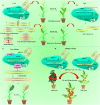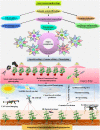Next-Generation Breeding Strategies for Climate-Ready Crops
- PMID: 34367194
- PMCID: PMC8336580
- DOI: 10.3389/fpls.2021.620420
Next-Generation Breeding Strategies for Climate-Ready Crops
Abstract
Climate change is a threat to global food security due to the reduction of crop productivity around the globe. Food security is a matter of concern for stakeholders and policymakers as the global population is predicted to bypass 10 billion in the coming years. Crop improvement via modern breeding techniques along with efficient agronomic practices innovations in microbiome applications, and exploiting the natural variations in underutilized crops is an excellent way forward to fulfill future food requirements. In this review, we describe the next-generation breeding tools that can be used to increase crop production by developing climate-resilient superior genotypes to cope with the future challenges of global food security. Recent innovations in genomic-assisted breeding (GAB) strategies allow the construction of highly annotated crop pan-genomes to give a snapshot of the full landscape of genetic diversity (GD) and recapture the lost gene repertoire of a species. Pan-genomes provide new platforms to exploit these unique genes or genetic variation for optimizing breeding programs. The advent of next-generation clustered regularly interspaced short palindromic repeat/CRISPR-associated (CRISPR/Cas) systems, such as prime editing, base editing, and de nova domestication, has institutionalized the idea that genome editing is revamped for crop improvement. Also, the availability of versatile Cas orthologs, including Cas9, Cas12, Cas13, and Cas14, improved the editing efficiency. Now, the CRISPR/Cas systems have numerous applications in crop research and successfully edit the major crop to develop resistance against abiotic and biotic stress. By adopting high-throughput phenotyping approaches and big data analytics tools like artificial intelligence (AI) and machine learning (ML), agriculture is heading toward automation or digitalization. The integration of speed breeding with genomic and phenomic tools can allow rapid gene identifications and ultimately accelerate crop improvement programs. In addition, the integration of next-generation multidisciplinary breeding platforms can open exciting avenues to develop climate-ready crops toward global food security.
Keywords: CRISPR/Cas; abiotic stress; climate change; crop improvement; food security; genome editing; genomics; next-generation breeding.
Copyright © 2021 Razzaq, Kaur, Akhter, Wani and Saleem.
Conflict of interest statement
The authors declare that the research was conducted in the absence of any commercial or financial relationships that could be construed as a potential conflict of interest.
Figures







Similar articles
-
De-novo Domestication for Improving Salt Tolerance in Crops.Front Plant Sci. 2021 Sep 16;12:681367. doi: 10.3389/fpls.2021.681367. eCollection 2021. Front Plant Sci. 2021. PMID: 34603347 Free PMC article. Review.
-
Conventional and Molecular Techniques from Simple Breeding to Speed Breeding in Crop Plants: Recent Advances and Future Outlook.Int J Mol Sci. 2020 Apr 8;21(7):2590. doi: 10.3390/ijms21072590. Int J Mol Sci. 2020. PMID: 32276445 Free PMC article. Review.
-
Evolution and Application of Genome Editing Techniques for Achieving Food and Nutritional Security.Int J Mol Sci. 2021 May 25;22(11):5585. doi: 10.3390/ijms22115585. Int J Mol Sci. 2021. PMID: 34070430 Free PMC article. Review.
-
Towards CRISPR/Cas crops - bringing together genomics and genome editing.New Phytol. 2017 Nov;216(3):682-698. doi: 10.1111/nph.14702. Epub 2017 Aug 1. New Phytol. 2017. PMID: 28762506 Review.
-
Plant breeding advancements with "CRISPR-Cas" genome editing technologies will assist future food security.Front Plant Sci. 2023 Mar 13;14:1133036. doi: 10.3389/fpls.2023.1133036. eCollection 2023. Front Plant Sci. 2023. PMID: 36993865 Free PMC article. Review.
Cited by
-
Revitalizing agriculture: next-generation genotyping and -omics technologies enabling molecular prediction of resilient traits in the Solanaceae family.Front Plant Sci. 2024 Feb 5;15:1278760. doi: 10.3389/fpls.2024.1278760. eCollection 2024. Front Plant Sci. 2024. PMID: 38375087 Free PMC article. Review.
-
Mechanisms of salinity tolerance and their possible application in the breeding of vegetables.BMC Plant Biol. 2023 Mar 14;23(1):139. doi: 10.1186/s12870-023-04152-8. BMC Plant Biol. 2023. PMID: 36915096 Free PMC article. Review.
-
CRISPR-Based Genome Editing for Nutrient Enrichment in Crops: A Promising Approach Toward Global Food Security.Front Genet. 2022 Jul 14;13:932859. doi: 10.3389/fgene.2022.932859. eCollection 2022. Front Genet. 2022. PMID: 35910203 Free PMC article. Review.
-
Genome-Environment Associations, an Innovative Tool for Studying Heritable Evolutionary Adaptation in Orphan Crops and Wild Relatives.Front Genet. 2022 Aug 5;13:910386. doi: 10.3389/fgene.2022.910386. eCollection 2022. Front Genet. 2022. PMID: 35991553 Free PMC article. Review.
-
Genomic resources, opportunities, and prospects for accelerated improvement of millets.Theor Appl Genet. 2024 Nov 20;137(12):273. doi: 10.1007/s00122-024-04777-9. Theor Appl Genet. 2024. PMID: 39565376 Free PMC article. Review.
References
-
- Allen M., Antwi-Agyei P., Aragon-Durand F., Babiker M., Bertoldi P., Bind M., et al. . (2019). Technical Summary: Global Warming of 1.5°C. An IPCC Special Report on the Impacts of Global Warming of 1.5°C Above Pre-Industrial Levels and Related Global Greenhouse Gas Emission Pathways, in the Context of Strengthening the Global Response to the Threat of Climate Change, Sustainable Development, and Efforts to Eradicate Poverty.
-
- Ampatzidis Y., Partel V. (2019). UAV-based high throughput phenotyping in specialty crops utilizing artificial intelligence, in 2019 ASABE Annual International Meeting. St Joseph, MI: American Society of Agricultural and Biological Engineers, 1. 10.13031/aim.201900293 - DOI
Publication types
LinkOut - more resources
Full Text Sources

